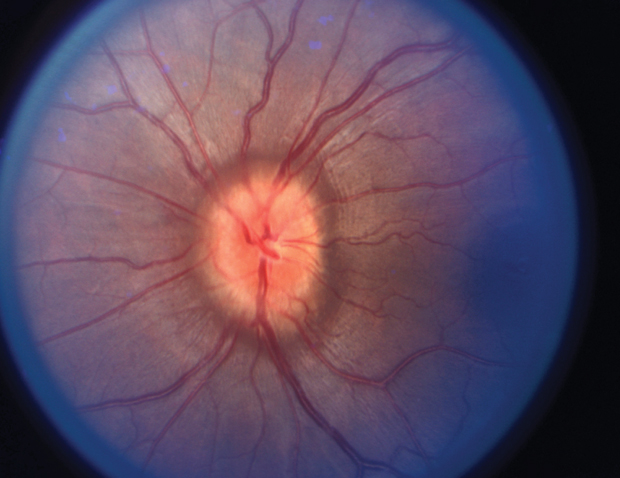MKSAP Quiz: Worsening headaches
A 26-year-old woman is evaluated for progressively worsening headaches that began intermittently 6 months ago and became daily 3 months ago. The patient describes bilateral “vise-like” pain that is steady, moderate in intensity, and unaffected by physical activity. She also has experienced brief, temporal, sharp pains and a few episodes of transient binocular visual dimming. The headaches are accompanied by moderate neck stiffness and mild photophobia but no nausea, phonophobia, or focal neurologic symptoms. She has polycystic ovary syndrome diagnosed 2 years ago and treated with metformin and a combined oral contraceptive but no personal or family history of headache. The patient takes no other medication or supplement.

On physical examination, blood pressure is 124/80 mm Hg and pulse rate is 72/min; BMI is 30. Partial left palsy of the abducens nerve (cranial nerve VI) is noted. A funduscopic photograph is shown.
An MRI is normal. Analysis of cerebrospinal fluid obtained on lumbar puncture shows an opening pressure of 350 mm H2O.
Which of the following is the most appropriate treatment?
A. Acetazolamide
B. Amitriptyline
C. Epidural blood patch
D. Optic nerve sheath fenestration
E. Spironolactone
Answer and critique
The correct answer is A. Acetazolamide. This question can be found in MKSAP 17 in the Neurology section, item 58.
The patient should be treated with acetazolamide. Although the headache described has many features of a tension-type headache, the findings of papilledema, partial left palsy of the abducens nerve (cranial nerve VI), and a cerebrospinal fluid (CSF) opening pressure of 350 mm H2O suggests the presence of a secondary headache syndrome. Documentation of an elevated CSF opening pressure without evidence of a space-occupying lesion on neuroimaging confirms the diagnosis of idiopathic intracranial hypertension (IIH). This condition is most frequently seen in young women with an elevated BMI. The use of a combined oral contraceptive is an additional risk factor. Headache is the most common symptom, and papilledema is the most common physical examination finding. Carbonic anhydrase inhibitors, such as acetazolamide, are the only reliably effective medications for IIH. These inhibitors have been shown to reduce headache and improve visual impairment in patients with IIH.
Amitriptyline is an effective preventive medication for migraine or tension-type headache but would not address this patient's elevated intracranial pressure and thus is inappropriate.
An epidural blood patch is used in the treatment of intracranial hypotension arising spontaneously or occurring after lumbar puncture. This patient has intracranial hypertension.
Optic nerve sheath fenestration involves an incision in the meninges surrounding the optic nerve (cranial nerve II) to relieve elevated intracranial pressure. Optic nerve sheath fenestration can be used in the treatment of IIH but only after the failure of medical management. If acetazolamide does not relieve this patient's symptoms, then optic nerve fenestration may be appropriate.
Spironolactone is a recognized therapy for polycystic ovary syndrome but has no reported effect on headaches or intracranial pressure.
Key Point
- Carbonic anhydrase inhibitors, such as acetazolamide, are the only reliably effective medications for idiopathic intracranial hypertension.




